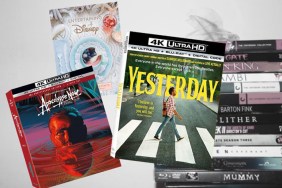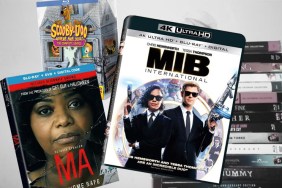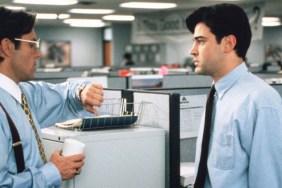Lots of screenwriters write epic tales of adventure, but most of them don’t have to compete with what is arguably the greatest American novel. Charles Leavitt didn’t shy away from the task when he began writing In the Heart of the Sea, the story of the deadly whale attack that also inspired Herman Melville’s 1851 novel Moby Dick. He researched the original event, as retold in Nathaniel Philbrick’s non-fiction book (also called In the Heart of the Sea), and like Melville he changed a bunch of stuff to make the story more interesting.
I talked to Charles Leavitt over the phone about that intriguing process. Here we have a screenwriting who was tasked with writing a “Based on a True Story” that would have to hold up to, arguably, the best “Based on a True Story” ever told. And he had to do it while serving filmmaker Ron Howard’s personal needs, and while keeping it on a budget, and while removing a lot of the female characters from the film.
Related: ‘In the Heart of the Sea’ Review | Too Big to Whale
Charles Leavitt describes those deleted scenes, and what changes he made to the history of the whaleship Essex in this exclusive interview. Beware of spoilers for In the Heart of the Sea, which is currently in theaters.
Crave: This is one hell of an ambitious project.
Charles Leavitt: [Laughs.] Yes! Yes it is, yes.
You’re telling the story that inspired Moby Dick.
Correct.
Obviously someone bought the rights to this book, but beyond that, why not just tell Moby Dick? What’s the significance for you?
The thing is, I wrote this script ten years ago. That’s how long it took to finally get to the screen. But I was given the book In the Heart of the Sea, because that’s when the book came out, and it was Barry Levinson’s company at the time that offered me the book to adapt. So the Melville/Moby Dick part of it didn’t really come into play until… When I read the book, which I loved, I had to try and figure out how to tell this story in a way that made sense as a movie. Because the book In the Heart of the Sea, itself, is structured so that one page one hundred the whale sinks The Essex, and then the whale swims off and we never see the whale again, and the rest of the book is about the survival of these men. In terms of a movie you can’t really tell all of that. It’s like two stories.
So I had to come up with a fictitious story of Melville because I knew that this incident, The Essex, this is where Melville got the inspiration for Moby Dick. This is where the idea entered his head to write Moby Dick, so I figured, well, I’ll take liberty here and invent the story of Melville coming to Nantucket to interview the former cabin boy, who is now an alcoholic innkeeper, Nickerson. And through Nickerson’s fuzzy account of it, or remembering, and also with Melville taking all this down, we can imagine that this is where the real story tapers off and where Melville’s imagination kind of begins.
In that way I could keep the whale in the movie, so to speak. The whale stays in the picture that way and only that way. So that’s how it became a movie with Melville as a character in there.

So what you’re saying is, if you didn’t have the framing device, you would have been obligated to tell it more the way it actually was.
Right, which would have not made sense as a movie… because for me, the whale is the thing that is the most compelling part. Certainly the survival story is compelling but the whale, the first time this whale hits the boat and everything that implies in terms of this whale industry, it kind of sent shockwaves through this industry. Because this was a business, risk versus profit, and they had accounted for all kinds of risks like with storms and such and all kinds of ways to lose ships, but they had never before figured that a whale was going to sink a ship. So that is something that they, after the survivors came back, something that they tried to repress, to keep secret.
So for me it was all about the whale. I knew you just couldn’t see the whale for two minutes and then that was it, so the Melville story became part of it. And of course Melville had heard. There had always been stories of this white whale sailors had encountered before, this giant white whale, and there had been a couple articles about it, but this was the one that sank The Essex and Melville years later read that account. It’s basically what really sparked him to write Moby Dick.
When you’re writing a whale, and it doesn’t have any dialogue, are you think of the whale as a character or more as a force of nature?
Well, both. It’s an embodiment of nature so in a way that is a character. Of course a whale can’t speak so it’s a matter of interpreting. What the sailors are saying, “This whale is looking and coming back, he’s looking at us.” So you have to experience the whale through the sailors’ point of view, but definitely the whale is a character. You have to think of it as a character.
So in your eyes, where did it come from? People have attempted to kill it before, and it’s bitter about that? Or is it more complicated?
You know, as in Moby Dick you have this whale that’s been attacked before and you see it’s scarred faces and there’s remnants of harpoons in it and stuff. So it’s kind of like it’s the embodiment of nature, and it’s defending. It is kind of the soldier, in a way, that’s going to stave off the humans from whaling.

I’m picturing the other whales hiring it.
[Laughs.] Yeah, there’s this moment – and in the movie Ron Howard portrayed this – these other whales are being hunted and the sound that they’re making, you assume that this giant whale is going to hear this and come. As Chase is banging to repair his boat, that kind of travels down into the water and stuff. In a way you can imagine the whale is being summoned, certainly. That’s a way to imagine it.
At the time these men believed that, and there was a religious justification Quakers used, that God has given man the dominion over all creatures, and the whale. So that was kind of a justification that they used for whale slaughter, and of course what we’re trying to say is, “No, man is not the dominant one here in the ocean.”
It’s interesting that you don’t shy away from the brutality of whaling, especially at the beginning of the film.
Of course, and that was hugely important because they… I believe there was an early movie version of Moby Dick, with Gregory Peck I think, in which whaling was portrayed as kind of a noble profession. The rendering scene in that movie was kind of uplifting with almost idyllic music going. But in the 21st century there has been a whole sea change of opinions are we’re sort of reassessing what our true relationship with nature is. So I had to portray this as brutally and horrifically as it really is.
And yet by its nature it has to be a rather expensive movie. Was there pushback on how far you could take it? Were there scenes you ended up having to rethink?
Well yeah. I mean that was up to Ron [Howard] but certainly the budget, he was given a very hard budget and he couldn’t veer from that, so working within that budget, trying to keep that under a hundred million dollars… which is, I’m amazed that Ron was able to actually do that, but he did it. Most of the big scenes were pretty much intact as they were in the script. I think really it was about, not only trying to get it under budget, but trying to keep a schedule really tight. So these actors really worked long days to try and get it in.

I want to get back to the framing device, because there’s an interesting dramatic structure you have in which the culminations of the elder version of Nickerson’s story isn’t the end of the film.
No, no, it’s not.
That’s a bold choice. Can you tell me what went into that?
It’s funny because in the script, it was in the movie the final scene, the line [Nickerson] uses is, “Oil from the ground, fancy that.” I had used that much earlier in the scene and Ron, to his credit, realized that he wanted that to end the movie. The last line. But certainly, as in the script, I felt that we were so invested in Pollard and Chase that you wanted that story to come to a close after Nickerson’s emotional, you know…
How I can picture it sort of working, and I’m curious if this was ever a part of the thought process or not, is almost like a Life of Pi structure where you don’t realize the extent of what Nickerson had to do to survive until the culmination of the inquest.
Yeah, no, absolutely. Yeah. I think that’s exactly how I thought of it.
Interesting, okay. The historical accuracy of a story like this, or a script like this, goes way over my head. I have no idea. So I want to know if there was anything you had to fudge just to get the story told?
Well, I’m just fudging the whole idea of the whale staying in the movie. That was kind of fudging it. That was a major fudge! But everything else was pretty accurate. You know, cannibalism, the inquest, everything. That all very much took place.
The only other [thing] in the script, the thing I kind of regret a little that they couldn’t put in the movie, were a couple scenes of the women back home. It would have given it a little… just painted it with a finer brush in a way. But you know, again, [that was a] directorial decision, and probably the right one.

Do you know if those scenes were filmed?
I don’t think they were, no.
I’ll probably never get to see those scenes, since they were never filmed: how did those scenes play out, with Chase’s wife for example?
When Chase returns there was a scene that I had where we go from him almost dying in the boat, and Nickerson kind of shaking him and saying there’s a bird. They see a seagull and he obviously turns his head, and there’s land.
And the next scene you’d see is his wife in Nantucket and she’s in the house and she’s using a sewing type machine, a spindle machine that’s made out of whale bone. Because I wanted to show that everything that these families… everything was about whales. They rocked their children to sleep in cradles made out of whale bone. Their combs and their kids toys, everything was balene and whale bone. We see through the spinning whale sewing machine that she looks out the window, and there’s this figure coming across the field toward her. And it’s Chase, and it’s almost like a ghostly figure, and is he real or not? Of course he is real and that’s kind of like the reunion scene between [Chase and] his wife. So it doesn’t happen on the dock like it does in the movie. [Laughs.] That I kind of missed, that scene the way I wrote it, but again that’s the way it was.
Then there was another scene where, because the ship had been sunken, no one had heard from The Essex for a long time, so all the wives were getting really antsy when no mail is coming back to them, and they go to the Folger-Macy’s company and protest, trying to demand to know what’s happening. So there was one little scene of that. But I understand that these decisions… [Laughs.] I’ve learned over my career that as the screenwriter, you basically have to give weight to the final vision of the director.
Well that’s why you should direct In the Heart of the Sea 2!
[Laughs.] No! No thanks! I’ll have to start with a much smaller movie. A much less ambitious movie.
Photos: Warner Bros.
William Bibbiani (everyone calls him ‘Bibbs’) is Crave’s film content editor and critic. You can hear him every week on The B-Movies Podcast and watch him on the weekly YouTube series Most Craved and What the Flick. Follow his rantings on Twitter at @WilliamBibbiani.








